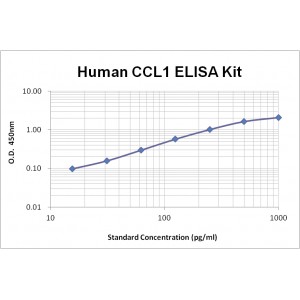More info
Assay Range | 15.6-1,000 pg/mL |
Sensitivity | 4.0 pg/mL |
Size | 96T |
Storage | Store at 2 - 8ºC. Keep reconstituted standard and detection Ab at -20 ºC |
Assay Principle | Sandwich ELISA |
Sample Volume | 100 µL final volume, dilution factor varies on samples |
Detection Method | Chromogenic |
Kit Components
1. Recombinant Human CCL1 standard: 2 vials
2. One 96-well plate coated with anti- Human CCL1 Ab
3. Sample diluent buffer: 12 mL - 1
4. Detection antibody: 130 µL, dilution 1:100
5. Streptavidin-HRP: 130 µL, dilution 1:100
6. Antibody diluent buffer: 12 mL x1
7. Streptavidin-HRP diluent buffer: 12 mL x1
8. TMB developing agent: 10 mL x1
9. Stop solution: 10 mL x1
10. Washing solution (20x): 25 mL x1
Background
CCL1 (C-C motif chemokine ligand 1), also known as small-inducible cytokine A1, T lymphocyte-secreted protein I-309, is a member of the CC chemokine family. CCL1 is a 96 amino acid (aa) small glycoprotein made up of a 23 aa hydrophobic signal peptide and a 73 aa mature protein. Human CCL1 shares approximately 42% aa sequence identity with mouse TCA3. Both chemokines contain an extra pair of cysteine residues absent in most other chemokines and exhibit significant sequence homology in the 5’ flanking region of their genes. Therefore, it is postulated that Human CCL1 may be the homolog of the mouse TCA3. CCL1 is secreted by activated T cells and shows chemotactic activity on monocytes, NK cells, as well as immature B cells and dendritic cells by interacting with a cell surface chemokine receptor called CCR8.


